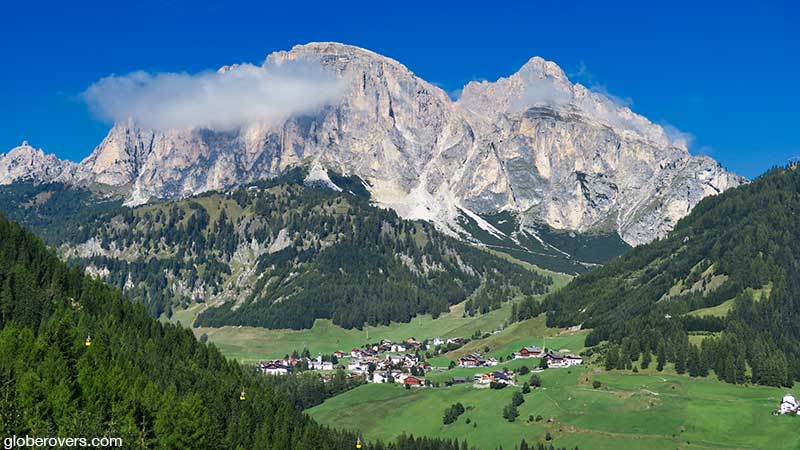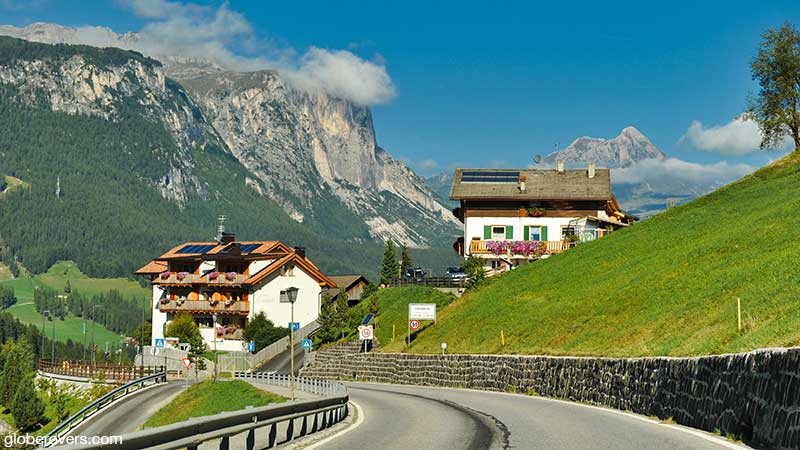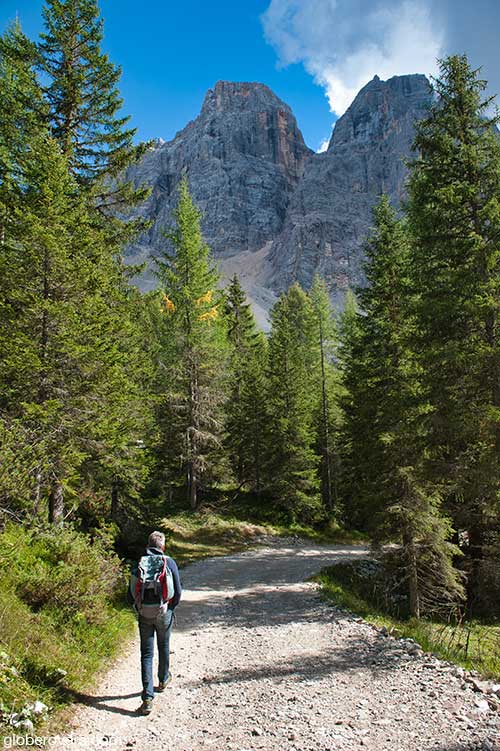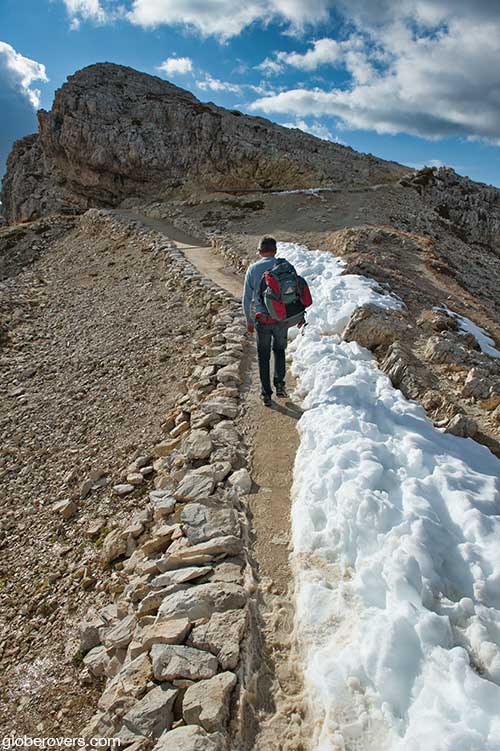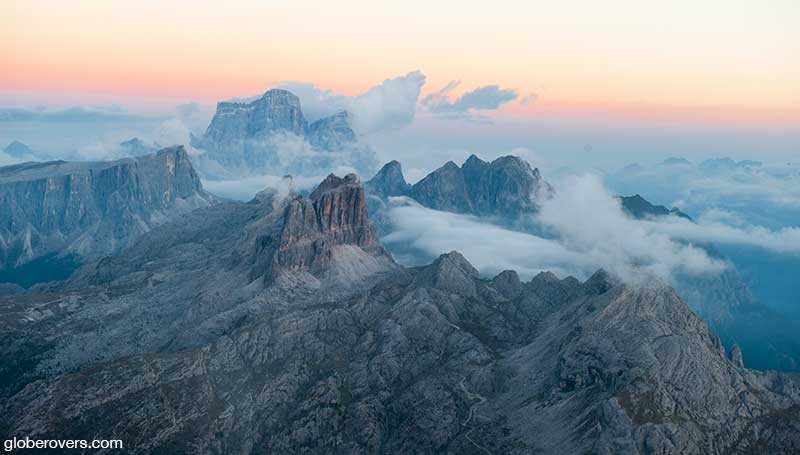
Massive bone-white and orange-yellow rock formations jutting out to gigantic proportions, surrounded by verdant valleys and low-hanging morning fog – complete with a vast network of World War 1 mountain tunnels and to top it off, a “rifugio” with spectacular panoramic views and Italian food to drool over. Yes, Italian. Welcome to the Italian Dolomites.
Whether at sunrise or at sunset, the brilliant colours
of the Italian Dolomites are mesmerising.
We explore the Italian Dolomites Mountains with Daniele Sommavilla who grew up in the area and remains a frequent year-round visitor.
Why travel to the Italian Dolomites?
- The low-down: Part of this experience is the drive towards the Dolomites mountains. At least one night at the top of the mountain is a must to see sunset and sunrise.
- The brightest highlight: Sunset and sunrise at the top of the Dolomites and sleeping in the cosy Lagazuoi Refuge (Rifugio Lagazuoi) – unforgettable!
- Intrepid destination: The area is visited by locals and those coming from far. It is busy all year round, though the Rifugio is open for a limited time.
- Globerovers score (10 is highest): Getting here and staying here is an incredible experience. I’ll score it 8/10.

Table of Contents
About the Italian Dolomites
The rock formations of the Dolomites, both the colour and shapes, are unique and quite different from the rest of the Alps. So strange is the combination of volcanic and dolomitic rock formations that they attracted the attention of French chemist and mineralogist, Deodat de Gratet de Dolomieu (1750-1801), after whom the mountains are named.
The discovery of an unknown mineral, calcium magnesium carbonate, CaMg(CO3)2, resulted in the labelling of this anhydrous carbonate mineral as “dolomite”. However, the entire Dolomite Mountains are not made of dolomite. The Latemar Peak, and also Marmolada the highest peak (3,343 metres), are limestone.
Imagine a fusion between the Swiss Alps and the mountains of Torres del Paine in the southern Chilean Patagonia region. Think Italian Dolomites!
While the imposing rock formations are the main draw to the region, adventurers flock to the area for trekking, caving, mountain biking, horse trekking, climbing, rafting, and several winter sports such as skiing, carving, sledding, tobogganing, snowboarding, and the list goes on.
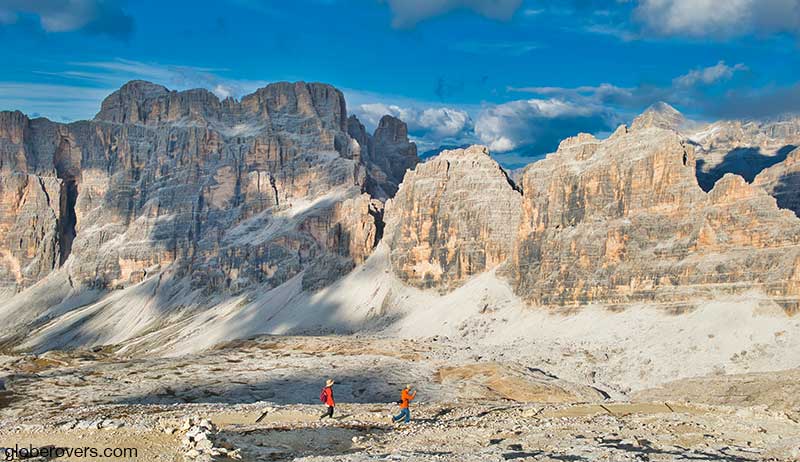
Evenings are spent around wood fires, enjoyed with Italian cuisines and regional wines such as the Teroldego, Nosiola, Lagrein and the Marzemino. Stay for the night at the Rifugio Lagazuoi with panoramic views in all directions. From here, explore the open-air museum of the Great War, aka World War 1 (WW1), then ski, or hike, down the famous Armentarola slope.
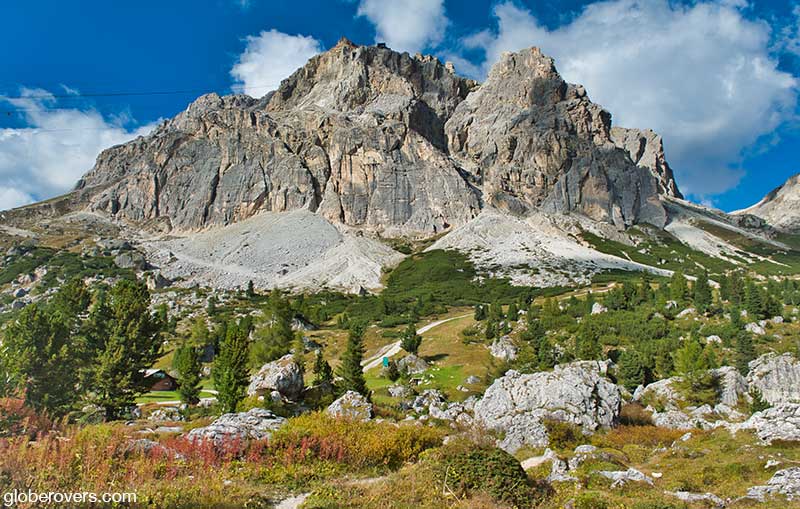
Getting to the Dolomites
The Dolomites (or Dolomiti in Italian) are located in the northeast of Italy, smack between the Austrian border to the north and the Venetian plains to the south. Spanning the northern Italian Veneto region, and the autonomous region of Trentino Alto-Adige, the Dolomites are proudly Italian! Being part of the Southern Limestone Alps which stretch across Italy, Austria and Slovenia, the Italian Dolomites tower above the Puster Valley to the north, and the Sugana Valley to the south.
Getting here is easy. Getting around on your own two feet is the challenge. And what an exciting challenge it is!

The closest international airport is the Marco Polo Venice Airport, 160 km to the south. Smaller airports are in Treviso, Verona and Innsbruk (Austria). The route from Venice is a pleasant 2.5-hour drive, which goes through several scenic places such as the “murals village” of Cibiana di Cadore, and the tranquil scenic location of the Rifugio Citta di Fiume. Milan, to the southwest, is a 4-hour drive away.
Your ideal starting point to the Dolomites is Mount Lagazuoi. Rising to a height of 2,835 m (9,301 ft), it is located about 18 km (11 mi) west of Cortina d’Ampezzo in the Veneto Region. Lagazuoi, debatably, is the highlight of the Dolomites. Lagazuoi is home to one of the most fascinating networks of World War 1 tunnels, the Rifugio Lagazuoi guesthouse with its 360 degrees panoramic views, and a network of hiking trails to reach the guesthouse at the top of the mountain.


Around Corvara, Alta Badia
No time to enjoy the trekking? Ascend Mount Lagazuoi by cable car, and in winter descend by sliding down the mountain on your skis or toboggan!
Getting up the Dolomites Mountain
There are two main options to get up the mountain: a cable car or an exhilarating hike.
Option 1: Falzarego-Lagazuoi Cable Car
The easy and thrilling way up the mountain is the Falzarego-Lagazuoi Cable Car at the Falzarego Pass. From the top of the Falzarego Pass at 2,117 m (6,946 ft), the cable car will whisk you up to the summit of Mount Lagazuoi at 2,762 m (9,062 ft) in approximately three minutes. It runs every 15 minutes from 09:00 to 16:40 uphill, while the last car to the bottom leaves at 17:00. A one-way ticket costs €10 while a roundtrip ticket is €15. Free parking is available at the bottom station, where you will find a hotel, souvenir shop, and a small chapel which you may want to visit before scaling the mountain.
Don’t forget that almost the entire upper part of Mount Lagazuoi is an open-air war museum, where thousands of soldiers died. As the cable car ascends, look out for the many tunnels piercing the side of the sharp cliffs.
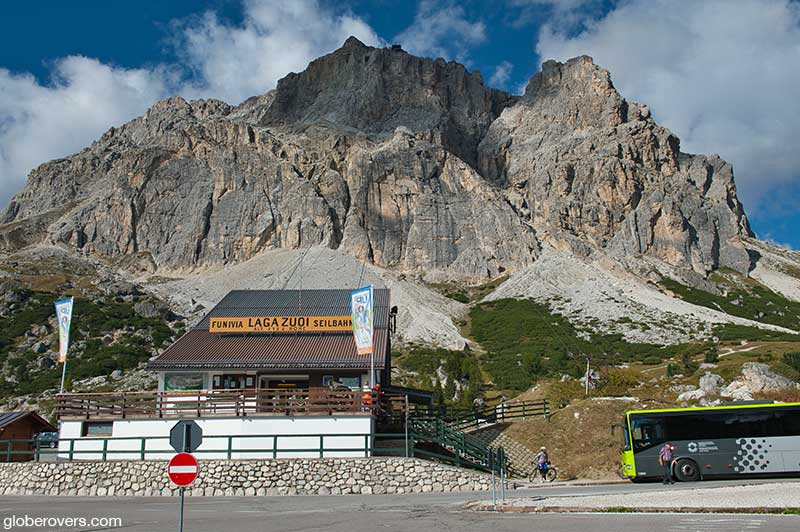
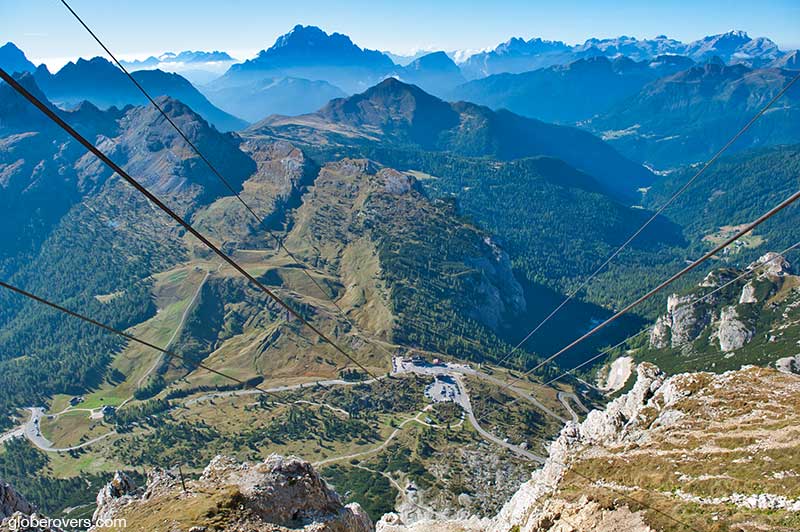
Option 2: Hiking up the mountain
Views from the summit, somehow, feel a lot more deserved when you hike up all the way! While the hike up the mountain is not that difficult, it will test your stamina. An exciting but challenging hike up the mountain commences at the parking space of Saré, south of San Cassiano.
Follow the meditative path of “Nikolaus von der Flühe”, known for its tranquillity and complete immersion into nature. The path passes the chapel of Sass Dlacià, Rifugio Capanna Alpina, and then Rifugio Scotoni from where a small path leads to the beautiful mountain lake of Lagazuoi in which the peaks of the Dolomites are reflected. Keep going until you cross the Dolomites ridgeway and eventually the Lagazuoi saddle to the Rifugio Lagazuoi and the upper station of the cable car.
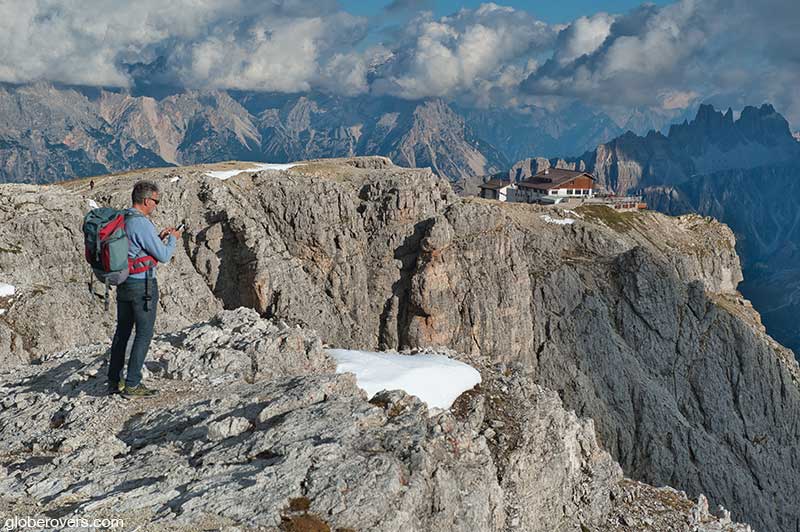
For a more leisurely experience, take the cable car up the mountain, and enjoy a few hours walking along the summit ridge which offers beautiful views of the surrounding mountains and valleys. After taking enough photos and eating a few strudels, or a full meal at the refuge restaurant, descend the mountain via one of the ski runs.
Best is not to descend via the path right below the cable car as this is not an easy way down. Rather go towards the saddle of Lagazuoi, past Forcella Travenanzes, and follow path number 401-402 which ends near the bottom station of the cable car. There are several paths descending from the summit. Ask around and choose a difficulty level to match your fitness and mindset.
The War Tunnels
Other than the incredible rock formations, the second most unique feature of the mountains is the war tunnels.
These high mountains served as the front lines in the war for land between the Italian and the Austrian armies during World War 1. Since the end of the Third Italian War of Independence in 1861, the border lines in this region have been disputed by the Italians and the Austrians. This dispute came to a boiling point in the early 1900’s when the Austrians claimed the strategic high positions of Mount Lagazuoi and a few other parts of the Dolomites.
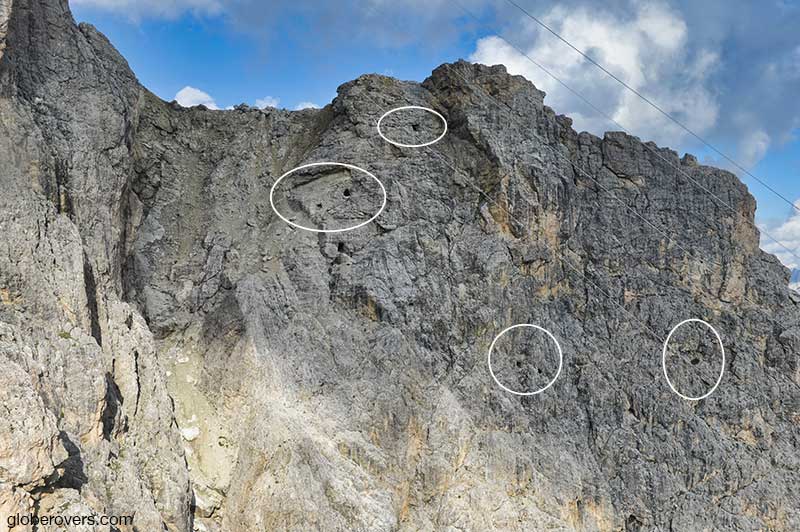
The Italians claimed these mountains to be theirs and were willing to fiercely fight to get them back. In a three-year struggle, starting in 1915, they fought to drive out the Austro-Hungarian army, during which time tens of thousands of soldiers lost their lives in battle, avalanches, accidents, and bitterly cold winters. In December 1916 more than 10 thousand soldiers on both sides were killed by avalanches, with 4,000 casualties on December 13th alone, known as White Friday.
The Austro-Hungarian army constructed fighting tunnels, often at high altitudes in the hard carbonate rock and even in glacial ice.
The Italians followed suit and dug miles of tunnels into the mountain as part of their plan to blow off the top of the mountain (Piccolo Lagazuoi) and drive out the Austrians. They were successful to greatly damage the mountain, and the war ended with the signing of the Armistice of Villa Giusti. The fate of the region was eventually decided in 1919 at the negotiation tables of Paris. The Italians were awarded the Dolomites while the new border was redrawn further to the northeast.
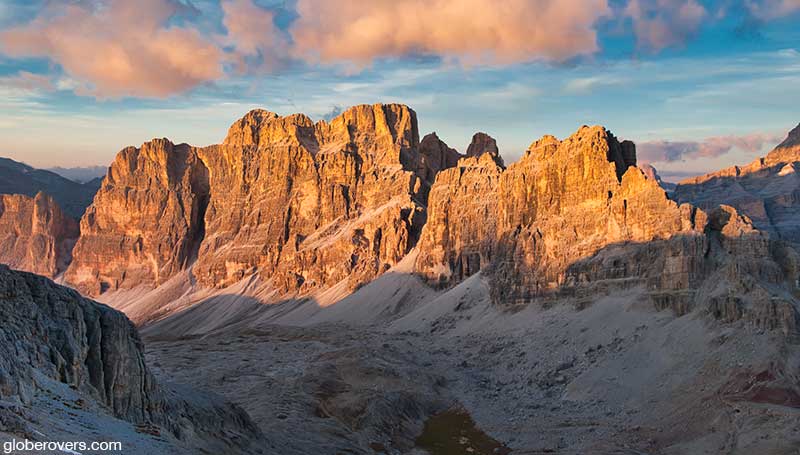
The war is long over! The Italians are guardians of the Dolomites while the Austrians have more snowy peaks than they can count. Now you can grab a flashlight, wear your helmet and walk these tunnels much like the soldiers did decades ago.
During 2018 a wide range of events in the region will celebrate 100 years since the War ended.
During your tunnel hikes you will come across remnants of the war such as gun turrets and bunkers, rusting shell casings, and of course the fortified trenches.
Refugio Lagazuoi at the top
Once you get off the cable car at the summit of Mount Lagazuoi, you have arrived at the Lagazuoi Refuge (Rifugio Lagazuoi). Situated at an altitude of 2,752 m (9,029 ft), Rifugio Lagazuoi is one of the highest mountain huts in the Dolomites. Its panoramic terrace offers an encompassing view of the surrounding mountains and deep valleys.
Drop your backpack inside the refuge and immediately go for a short hike along the ridge of the summit. From here you have incredible views in all directions. Make sure to walk to the famous summit cross that was erected in memory of the soldiers who were killed on this mountain in World War I.

During the summer season, and at the height of the skiing season, the refuge can get very busy during the daytime, particularly during meal times. Sleeping place is limited, so if you want to overnight which is highly recommended, you’d better book long in advance. The refuge is a great base for visiting the WW1 tunnels, for hiking around the area, and for skiing in the Cortina and Badia Valleys.
From the refuge, you can ski down the famous Armentarola slope which is one of the longest and most spectacular ski slopes in the Dolomites. Lagazuoi and Cortina are one of the 12 ski areas that constitute the Dolomiti Superski, a 1,200 km network of dreamlike-shaped slopes and state-of-the-art lift facilities configured to create the biggest ski resort in the world.
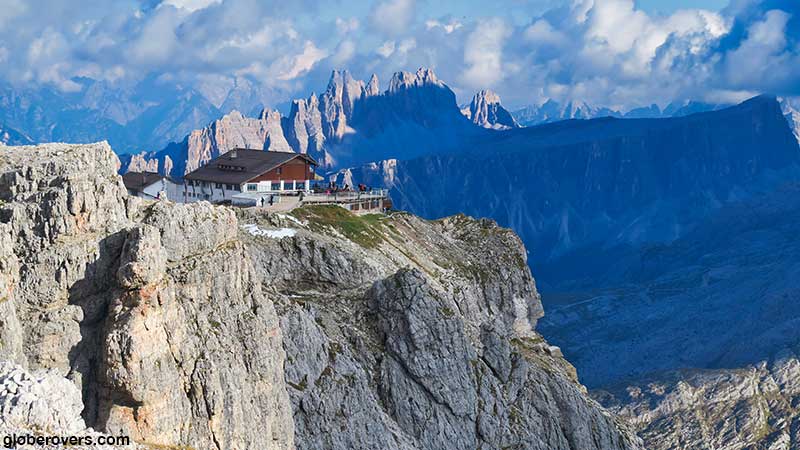
After a full day of trekking, tunnel crawling, skiing, or whatever action you endeavoured, recline with a cold beer or warm drink from the bar and watch the setting sun over the mountain peaks. The set meals, of typical local cuisine, are sumptuous and served up three times a day. Then, settle for some quality time in the charming Finnish sauna, the highest sauna in the Dolomites. Don’t miss the views during sunrise. The blue-pinkish hues against the mountains and the low-hanging clouds and early morning fog over the valleys are surreal.
The winter season at Rifugio Lagazuoi normally starts from around 6th December to the middle of April, while the summer season is from early June to early October. Outside these two seasons, the refuge is closed. The refuge has a total of 74 beds of which 18 are in private bedrooms and 56 in shared dormitories. Only shared bathroom facilities with limited water supply are available. The refuge offers a ski-boot dryer, slippers, bed sheets, towels, and a small wellness area.

During the 2018 season, twin rooms are €108 to €111, triple rooms are €165, and quadruple rooms €220. Bunk bed dormitories which vary from six to 14 people in a room, cost €44.40 per person including a sumptuous breakfast. A hot shower is extra at €3.50 per token. Dorms were built in 1987 and bathroom facilities were completely renovated in 2015. Great facilities indeed!
Once you have visited the Italian Dolomites, the Dolomites will always be on your mind. This I can promise you! So get packing and explore northern Italy.


Views from Rifugio Lagazuoi, Dolomites, Italy
Wines of the Dolomites
Written by Elisabetta Tosi, an experienced Italian freelance wine journalist and wine blogger, and new media consultant. From Valpolicella (close to Verona, in Veneto region) where she lives, she usually writes about Italian wines and wineries for international online and offline magazines and is always ready to jump into new travel adventures.
www.vinopigro.it | www.fermentidigitali.com | Twitter: @VinoPigro
Awesome mountains, beautiful alpine lakes (there are over 300 of them), stunning landscapes: the Italian Trentino region is a jewel waiting to be discovered!
Even if you are just coming for the wines and the wineries, you certainly won’t be disappointed. This wine growing area of the Italian Dolomites has everything to make you happy. Very happy!
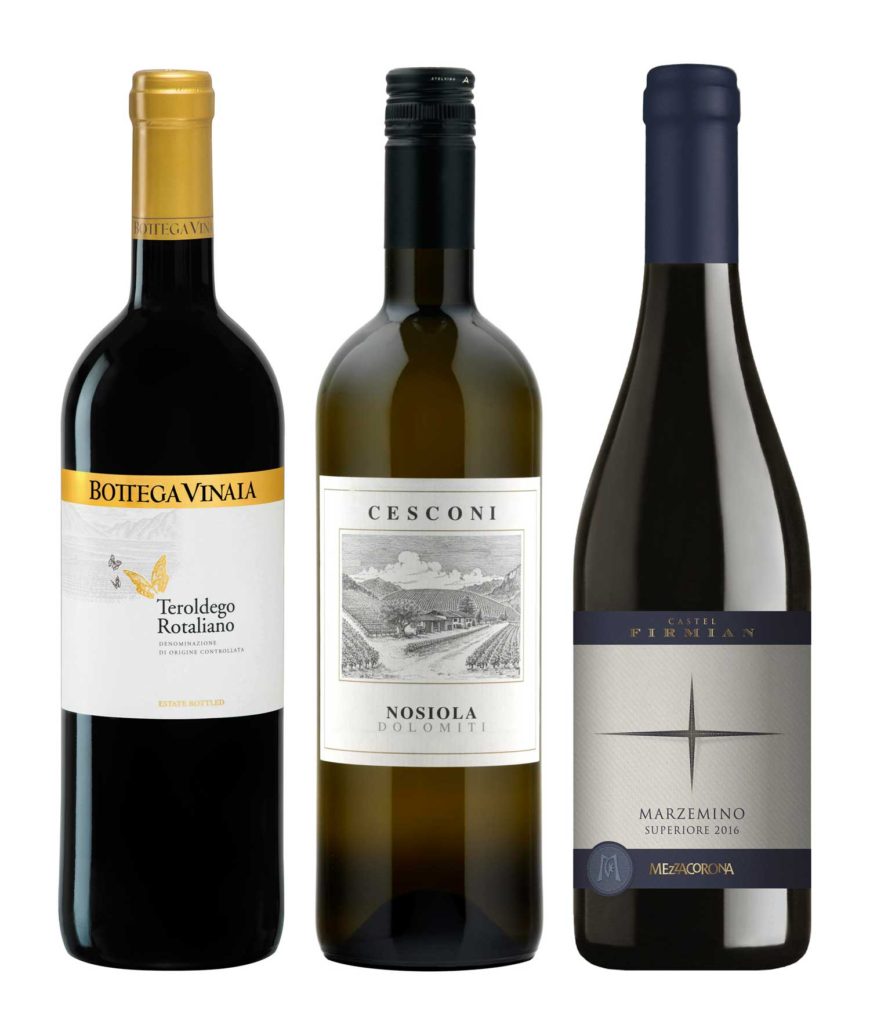
Once you cross the valley of the Adige River from Verona to Trento, you will get your first glimpses of an impressive canyon where the river flows through a couple of narrow loops: the so-called Chiusa (“closed” in the Italian language) of Ceraino, a tiny village. After just a few kilometres, you will see the first vineyards!
From Veneto to Trentino, the vines dominate the landscape, from the lower valleys all the way up to the steepest slopes on the hills. Trentino boasts a centuries-old and well-established enology and winemaking tradition of the highest standard. The average annual harvest is about 1 million hectolitres of grapes, cultivated over an area in excess of 10,000 acres. This is a drop in the ocean compared to the land dedicated to vineyards worldwide, but here the soil is superb for grapes.
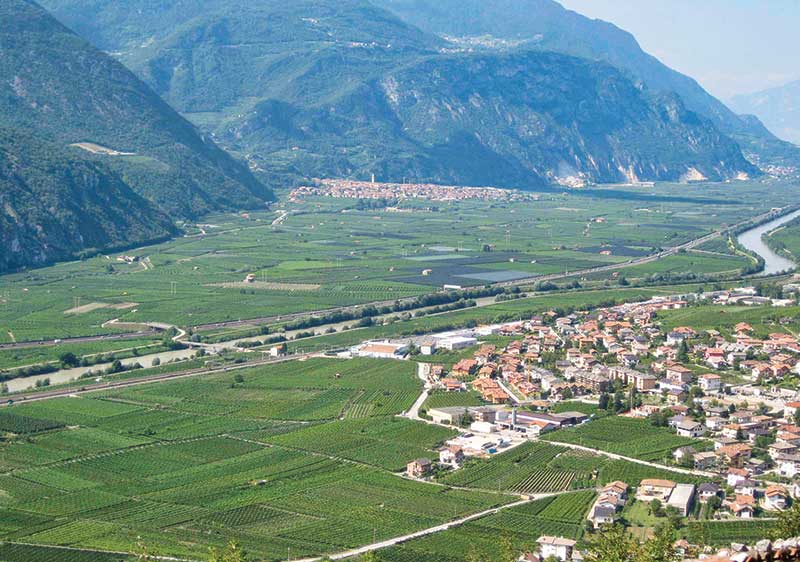
The varieties cultivated are both local and international, but without a doubt the most loved ones by winemakers and wine lovers alike, are the original cultivars: the regal Teroldego, the gentle Nosiola, the friendly Marzemino. The “Prince”, the “Lady” and the “Jolly” in the deck of cards of wine production in this region.
Teroldego is regarded as the prince of Trentino’s red wines. It originated in the so-called Campo Rotaliano (Rotaliano’s Field), a vast plain situated north of Trento. It is amongst the darkest red wines in the world, and in ancient legends was compared to the blood of a dragon. It is a well-balanced, clean and elegant wine. The nose detects hints of red and black small berries with violet flowers, while the tongue detects a spicy and balsamic character.
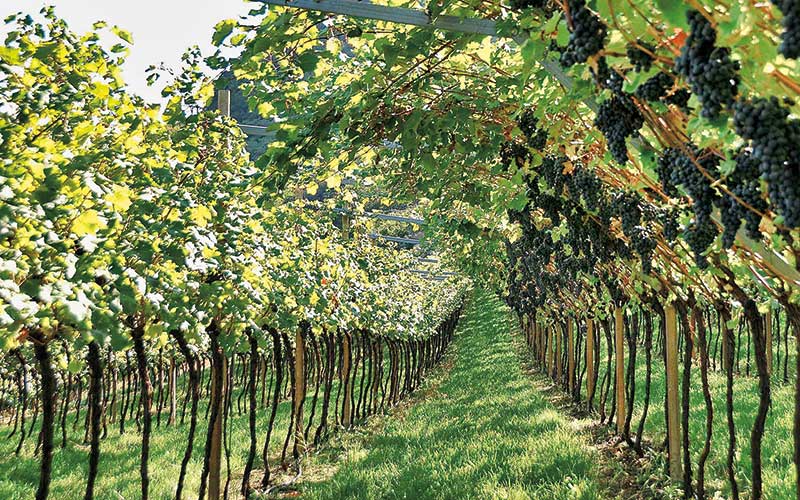
Totally different is the bright and gentle Nosiola, the lady: a white grape that produces wine with the taste of wild hazelnuts. The name is derived from the Italian word for hazelnut, nocciola, which is the dominant aroma found in Nosiola wines. The grapes are cultivated in areas where the brisk afternoon breeze named “Ora del Garda” or “Garda’s Ora” (Ora from the Latin word “Aura” meaning “beneficial breath”), helps to dry off the afternoon rains and enhances the ripening of the grapes.
Nosiola is a versatile, fresh and easy-to-drink wine while still is in its youth. However, if made with dried grapes, it changes dramatically and becomes a precious, lavish, and surprisingly silky sweet wine. Production of this “Vino Santo” is quite limited.
☛ Read more: Western Europe posts
Last, but not least, is the jolly Marzemino, famously mentioned as “Versa il vino! Eccellente Marzemino!” in Mozart’s “Don Giovanni” opera. It is a fresh and easy-to-drink red wine, gentle and friendly. To the nose, this wine offers scents of plums, violets, and wild berries; to the palate, it is fruity, delicate and very pleasant. When you are in the Trentino region, try it paired with a pizza. Trust me, you won’t regret it.
Wine Tasting:
Enoteca Provinciale del Trentino
Palazzo Roccabruna,
via SS.Trinità, 24
Trento
Tel.+39.0461.887101
Wine Tasting:
Cantina di Toblino
Hosteria and wine shop: Via Longa, 1
Sarche – Madruzzo (TN)
Tel: +39.0461 564168


Further reading:
- Best Places To Visit In The Dolomites Italy
- Stunning Day Hikes in the Dolomites
- The Dolomites Travel Guide

Blog post and photos by Peter who has been travelling almost full-time since 2005 and has been to over 122 countries. He visited several countries, such as Japan, more than 20 times. Peter is Editor-in-Chief and Publisher of GlobeRovers Magazine, an independent travel magazine focused on intrepid destinations.

